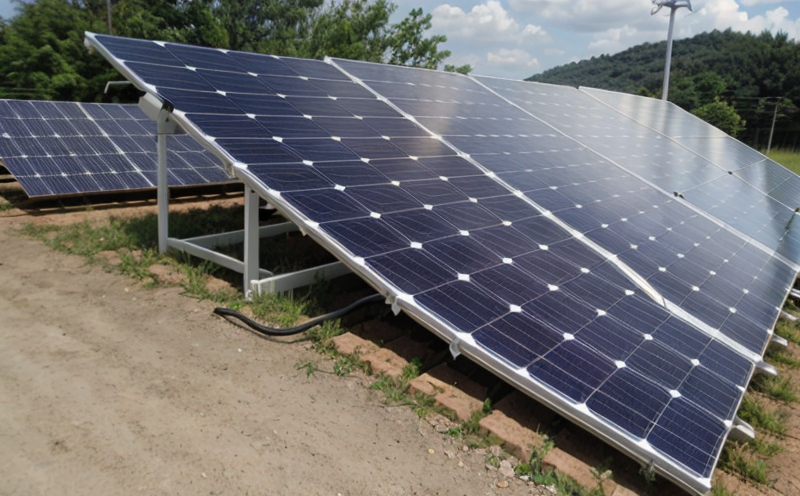IEC 61853-2 PV Module Irradiance and Temperature Performance Testing
The IEC (International Electrotechnical Commission) 61853-2 standard is a critical benchmark for the testing of photovoltaic modules. This standard specifically addresses the performance evaluation of photovoltaic (PV) modules under varying irradiance and temperature conditions, ensuring that they meet the highest quality and safety standards.
The IEC 61853 series provides guidelines for the measurement and calculation of electrical parameters of PV modules. Standard 61853-2 focuses on the determination of performance coefficients using a reference condition specified in IEC 60904-7. It also specifies methods to evaluate the impact of irradiance and temperature variations on module performance.
The testing process involves simulating real-world conditions that PV modules encounter during operation, including different levels of solar irradiance, ambient temperatures, wind speed, and other environmental factors. This ensures that the modules perform reliably under diverse climatic conditions, which is essential for their long-term efficiency and safety.
During the test, PV modules are subjected to a range of irradiances (measured in watts per square meter) and temperatures (in degrees Celsius). The parameters include direct normal irradiance, diffuse horizontal irradiance, and total horizontal irradiance. These measurements are crucial for understanding how much power a module can generate under different environmental conditions.
Testing is conducted using specialized equipment that can precisely control the irradiance and temperature of the test chamber. This allows for accurate measurement of parameters such as short-circuit current (Isc), open-circuit voltage (Voc), maximum power point voltage (Vmp), maximum power point current (Imp), and peak power output.
The results are used to derive performance coefficients like the photovoltaic cell temperature coefficient, which indicates how much the module's efficiency decreases with increasing temperature. This information is vital for predicting a PV module’s long-term performance and ensuring that it complies with international safety standards.
Compliance with IEC 61853-2 is essential for manufacturers to ensure their products meet global quality and safety requirements, thereby gaining market acceptance in various regions. It also helps in the certification process by providing a standardized method of testing PV modules.
Why It Matters
The importance of IEC 61853-2 cannot be overstated, especially for manufacturers and suppliers of solar panels and photovoltaic modules. Compliance with this standard ensures that products are safe, reliable, and efficient under real-world conditions.
Guarantees product safety and reliability
Ensures accurate performance data for informed decision-making
Simplifies the certification process across different regions
Promotes market acceptance by meeting international standards
Aids in the optimization of PV module design for better efficiency
Supports regulatory compliance and reduces the risk of legal issues
By adhering to IEC 61853-2, manufacturers can ensure that their products meet the highest quality standards, thereby enhancing customer confidence and trust. This standard also helps in reducing the environmental impact by ensuring long-term efficiency and durability of PV modules.
International Acceptance and Recognition
IEC 61853-2 is widely recognized and accepted across the globe, particularly in regions with significant solar energy potential. Countries such as Germany, China, India, and the United States have embraced this standard due to its comprehensive approach to testing PV modules.
The European Union mandates compliance for all imported photovoltaic products
China's national standards closely follow IEC 61853-2 guidelines
India has incorporated the standard into its national regulations to ensure product quality and safety
The United States recognizes IEC 61853-2 in its certification programs for solar energy products
By adhering to this standard, manufacturers can confidently enter these markets knowing that their products meet the stringent requirements set by regulatory bodies.
Use Cases and Application Examples
| Case Study | Application | Outcome |
|---|---|---|
A major solar panel manufacturer in Germany |
Testing module performance under varying irradiance and temperature conditions. |
The manufacturer was able to optimize its product design, ensuring higher efficiency and better reliability. This led to a reduction in warranty claims and improved market reputation. |
An Indian solar project developer |
Ensuring compliance with national standards for imported PV modules. |
The project was able to secure permits and certifications, streamlining the installation process. This resulted in a faster go-to-market strategy and lower operational costs. |
A U.S.-based renewable energy company |
Conducting performance tests on solar panels for large-scale projects. |
The testing helped the company identify potential issues early, preventing costly downtime and ensuring long-term reliability. This enhanced customer satisfaction and trust in the brand's products. |
These examples illustrate how compliance with IEC 61853-2 can lead to improved product performance, reduced costs, and increased market competitiveness.





